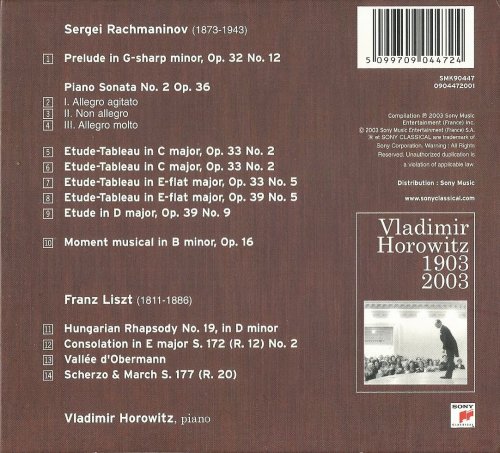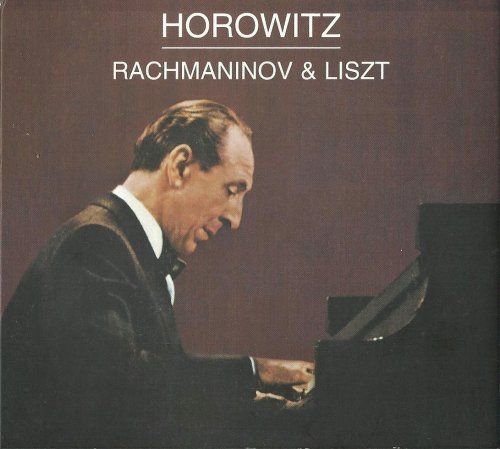
Vladimir Horowitz - Rachmaninov & Liszt: Piano Works (2003)
BAND/ARTIST: Vladimir Horowitz
- Title: Rachmaninov & Liszt: Piano Works
- Year Of Release: 2003
- Label: Sony Classical
- Genre: Classical
- Quality: FLAC (image+.cue,log,scans)
- Total Time: 78:23
- Total Size: 340 Mb
- WebSite: Album Preview
Tracklist:
Sergei Rachmaninoff (1873-1943)
01. Prelude in G-Sharp minor, Op. 32 No. 12 [0:02:58.09]
02. Piano Sonata No. 2 Op. 36 - I. Allegro agitato [0:08:28.31]
03. Piano Sonata No. 2 Op. 36 II. Non allegro [0:06:10.46]
04. Piano Sonata No. 2 Op. 36 III. Allegro molto [0:05:21.17]
05. Etude-Tableau in C-major, Op. 33 No. 2 [0:02:27.43]
06. Etude-Tableau in E-flat major, Op. 33 No. 5 [0:01:41.46]
07. Etude-Tableau in E-flat major, Op. 39 No. 5 [0:04:44.36]
08. Etude-Tableau in D major, Op. 39 No. 9 [0:03:34.17]
09. Moment musical in B minor, Op. 16 [0:06:45.37]
Franz Liszt (1811-1886)
10. Hungarian Rhapsody No. 19, in D minor [0:09:44.70]
11. Consolation in E major S. 172 (R. 12) No. 2 [0:03:31.61]
12. Vallee d'Obermann [0:12:48.33]
13. Scherzo & March S. 177 (R. 20) [0:10:28.03]
Performers:
Vladimir Horowitz - piano

Sergei Rachmaninoff (1873-1943)
01. Prelude in G-Sharp minor, Op. 32 No. 12 [0:02:58.09]
02. Piano Sonata No. 2 Op. 36 - I. Allegro agitato [0:08:28.31]
03. Piano Sonata No. 2 Op. 36 II. Non allegro [0:06:10.46]
04. Piano Sonata No. 2 Op. 36 III. Allegro molto [0:05:21.17]
05. Etude-Tableau in C-major, Op. 33 No. 2 [0:02:27.43]
06. Etude-Tableau in E-flat major, Op. 33 No. 5 [0:01:41.46]
07. Etude-Tableau in E-flat major, Op. 39 No. 5 [0:04:44.36]
08. Etude-Tableau in D major, Op. 39 No. 9 [0:03:34.17]
09. Moment musical in B minor, Op. 16 [0:06:45.37]
Franz Liszt (1811-1886)
10. Hungarian Rhapsody No. 19, in D minor [0:09:44.70]
11. Consolation in E major S. 172 (R. 12) No. 2 [0:03:31.61]
12. Vallee d'Obermann [0:12:48.33]
13. Scherzo & March S. 177 (R. 20) [0:10:28.03]
Performers:
Vladimir Horowitz - piano
This very generous (79 min.) program of Rachmaninov and Liszt is a sterling representation of Horowitz's mastery in these two composers. It was issued in 2003 as a centennial tribute to the pianist, and quite a number of readings derive from live concerts. the span of time is relatively short - most of the performances come from 1967 and 1068, with several more from 1962, before he ended his self-imposed exile from concertizing. The sonics from that period could be a bit thin and shallow, but they are good enough, and at times, as in Rachmaninov's Etude-Tableau Op. 39 no. 5, Horowitz's full range of sound jumps out, making one wish that everything was this present and engrossing.
Although the music world was jubilant about his return to the concert stage in 1965, there was also talk that the old diabolical Horowitz was no longer. In retrospect, we're thankful for any Horowitz, given his unique stature and rare gifts. but you do hear him at lower voltage sometimes. I find that from the Sixties onward the really thrilling performances are mixed into lesser ones, even though this is always Horowitz. In the Rachmaninov half of the program, the Prelude in G-sharp minor that begins the CD makes one bow in homage, as does the Etude Tableau I mentioned and the simple, melodic Moment musical in B minor at the end, a magical example of recreating a piece as if through direct inspiration.
Horowitz did some tinkering with Rachmaninov; the version of Sonata no. 2 heard here was an amalgam of the original and revised editions, plus extra editing by the pianist. It was in Liszt, however, that Horowitz let loose his imagination as a reviser. He says that he did this for the sake of "musical brilliance," as opposed to empty brilliance. I'm not so sure, but the result always sounds Horowitzian, with passing little clinkers to spice up the harmonies, crashing octaves in the left hand, and a dash of superhuman difficulty where it would drive the audience into a frenzy.
Of the four Liszt pieces included here, only the late Hungarian Rhapsody no. 19 gets a Horowitz makeover, and it's worth every dazzling second, even if this particular rhapsody is rather subdued - one still marvels at Horowitz's touch in all the music's shifting moods; the quickest, lightest passages are among the most hypnotic. The recorded sound is also quite good. The rarely heard Scherzo and March S. 177 was done only once by him in concert, at Queens college in 1967, as heard here. The piece is brass-plated claptrap, but Horowitz's whizzing fingers put on quite a show.
The two other Liszt works are quiet, with the short Consolation no. 2 a lovely example of Horowitz'a unaffected poetics as he aged. He takes a poetic view of Vallee d'Obermann, too, but I'm not sure that this work is all snowflakes at twilight. the reading doesn't go deep enough into the shadows, and I wish that it built upon each repetitive section. However, this reading from 1966 has its admirers, and if I feel a bit disappointed, every other selection here is intelligently chosen and fascinating to hear. I would rate this CD among the best of Sony's many Horowitz compilations.
Although the music world was jubilant about his return to the concert stage in 1965, there was also talk that the old diabolical Horowitz was no longer. In retrospect, we're thankful for any Horowitz, given his unique stature and rare gifts. but you do hear him at lower voltage sometimes. I find that from the Sixties onward the really thrilling performances are mixed into lesser ones, even though this is always Horowitz. In the Rachmaninov half of the program, the Prelude in G-sharp minor that begins the CD makes one bow in homage, as does the Etude Tableau I mentioned and the simple, melodic Moment musical in B minor at the end, a magical example of recreating a piece as if through direct inspiration.
Horowitz did some tinkering with Rachmaninov; the version of Sonata no. 2 heard here was an amalgam of the original and revised editions, plus extra editing by the pianist. It was in Liszt, however, that Horowitz let loose his imagination as a reviser. He says that he did this for the sake of "musical brilliance," as opposed to empty brilliance. I'm not so sure, but the result always sounds Horowitzian, with passing little clinkers to spice up the harmonies, crashing octaves in the left hand, and a dash of superhuman difficulty where it would drive the audience into a frenzy.
Of the four Liszt pieces included here, only the late Hungarian Rhapsody no. 19 gets a Horowitz makeover, and it's worth every dazzling second, even if this particular rhapsody is rather subdued - one still marvels at Horowitz's touch in all the music's shifting moods; the quickest, lightest passages are among the most hypnotic. The recorded sound is also quite good. The rarely heard Scherzo and March S. 177 was done only once by him in concert, at Queens college in 1967, as heard here. The piece is brass-plated claptrap, but Horowitz's whizzing fingers put on quite a show.
The two other Liszt works are quiet, with the short Consolation no. 2 a lovely example of Horowitz'a unaffected poetics as he aged. He takes a poetic view of Vallee d'Obermann, too, but I'm not sure that this work is all snowflakes at twilight. the reading doesn't go deep enough into the shadows, and I wish that it built upon each repetitive section. However, this reading from 1966 has its admirers, and if I feel a bit disappointed, every other selection here is intelligently chosen and fascinating to hear. I would rate this CD among the best of Sony's many Horowitz compilations.

Classical | FLAC / APE | CD-Rip
As a ISRA.CLOUD's PREMIUM member you will have the following benefits:
- Unlimited high speed downloads
- Download directly without waiting time
- Unlimited parallel downloads
- Support for download accelerators
- No advertising
- Resume broken downloads


